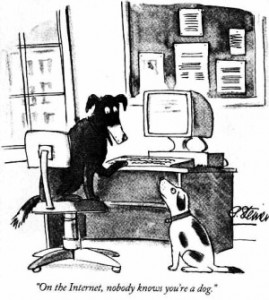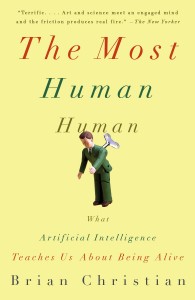Cyborgs, communication, and death have been topics that have come up in Whitehead and Wesch’s Human No More.

A few weeks ago, we talked about the Turing test and whether we are able to tell whether a dog (AI) or human is behind a chatbox. Every year, a competition is hosted to give out awards to the most Human human chatbox, and to the AI that makes it difficult for the judges to differentiate between the AI chatbox and the human chatbox.
 Brian Christian has wrote the book The Most Human Human: What Artificial Intelligence Teaches us about Being Alive. The book provides a glimpse into what it means to be human, at the most basic level: “to learn, to communicate, to intuit and to understand.” We tend to look at the meat world and the virtual world as a product of our interactions in the meat world. This book takes a different approach, by seeing how we can use AI and technology to revisit the most basic characteristics that keep us grounded in the meat world. “While information technology seems to promise greater equality through access and networking, it also seems to merely reproduce social life” (Haraway).
Brian Christian has wrote the book The Most Human Human: What Artificial Intelligence Teaches us about Being Alive. The book provides a glimpse into what it means to be human, at the most basic level: “to learn, to communicate, to intuit and to understand.” We tend to look at the meat world and the virtual world as a product of our interactions in the meat world. This book takes a different approach, by seeing how we can use AI and technology to revisit the most basic characteristics that keep us grounded in the meat world. “While information technology seems to promise greater equality through access and networking, it also seems to merely reproduce social life” (Haraway).
Also, although Facebook and other online platforms have allowed digital artifacts of ourselves to remain posthumously, in what ways might those artifacts represent or misrepresent us?